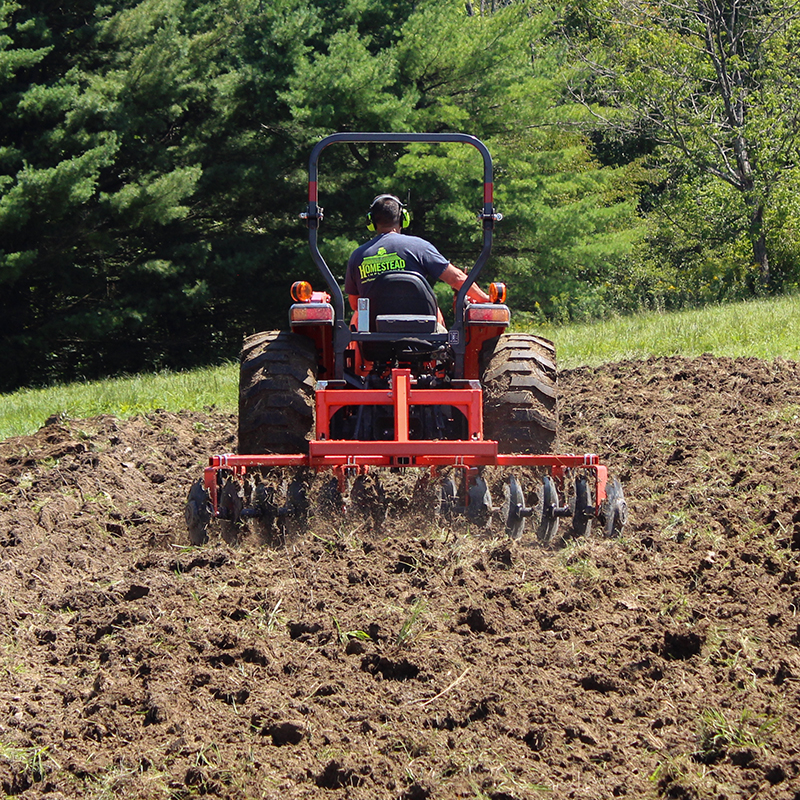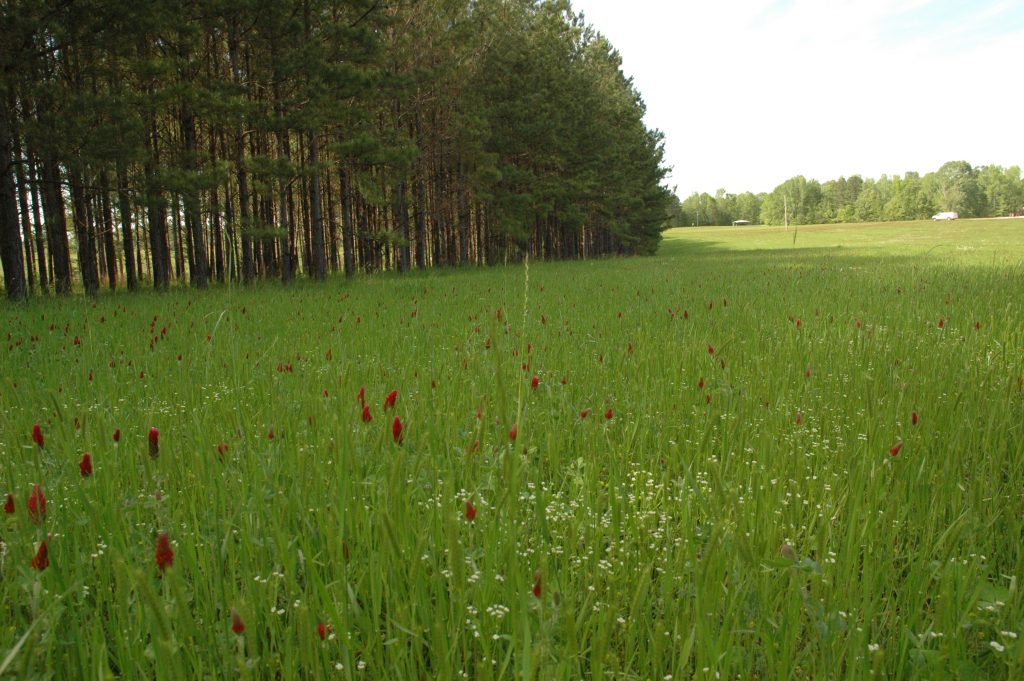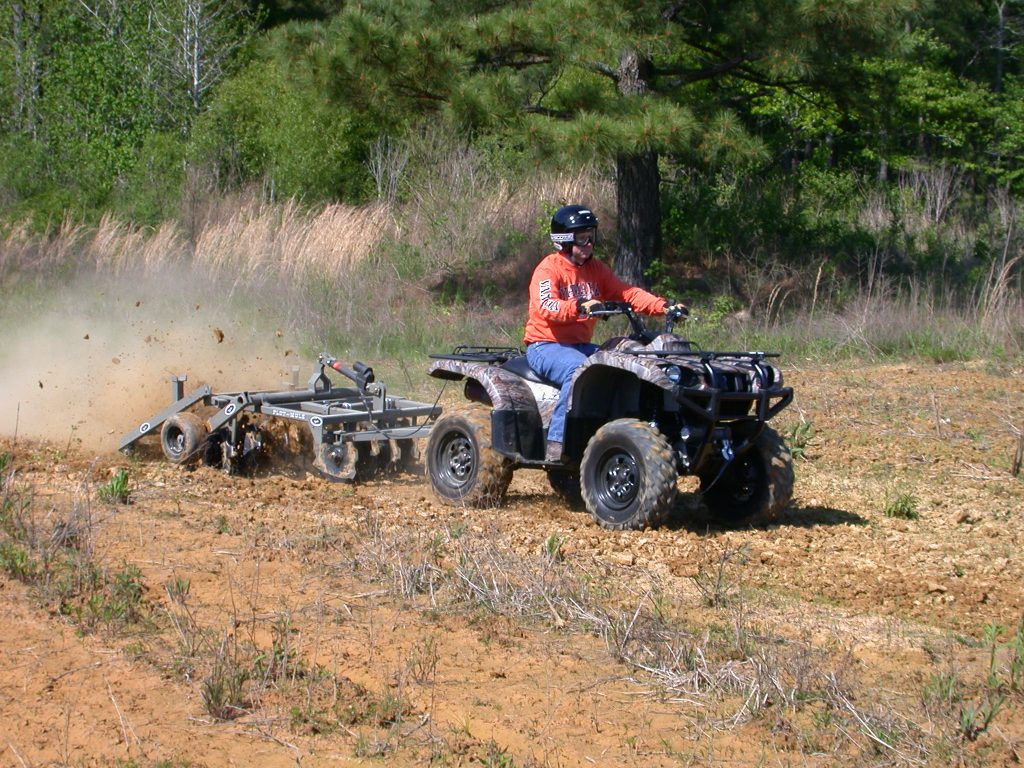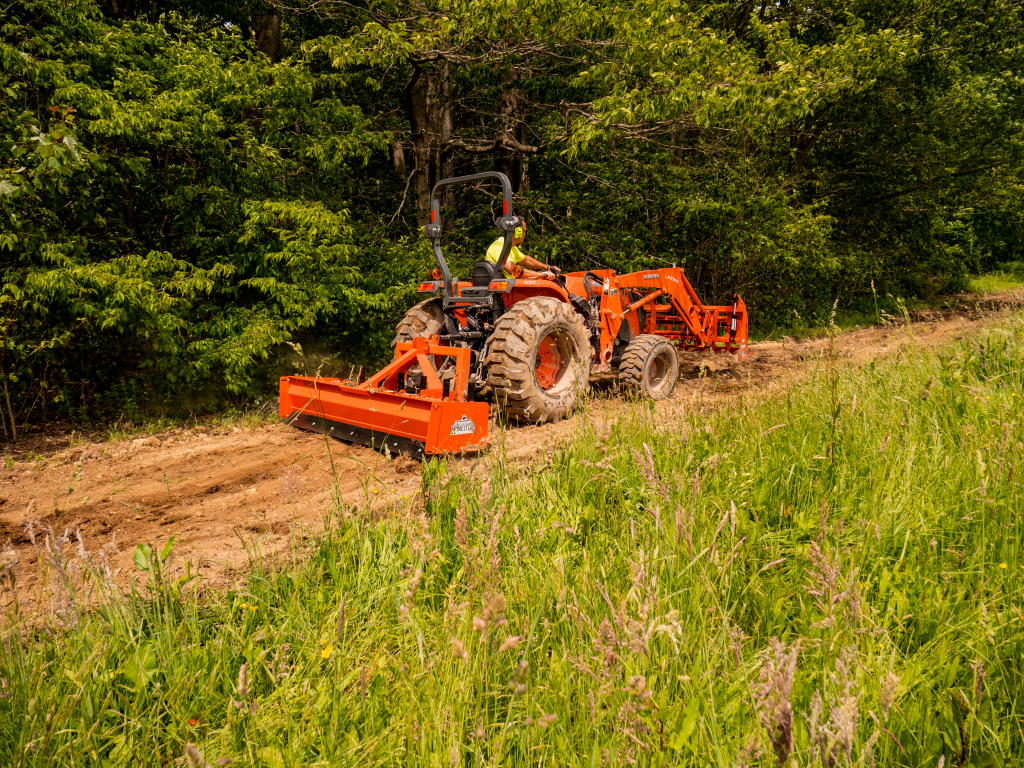Whether you’re an avid hunter looking to create a highly attractive destination for wildlife or a landowner looking to improve your property’s habitat and soils, creating a successful food plot requires the right tools. With a plethora of food plot equipment options available, navigating the choices can be overwhelming.The good news is, this guide is here to equip you with all the essential information you need to transform your land into a wildlife destination. From tractors to ATVs, no-till methods to financing options, we’ll explore the full spectrum of food plot equipment, allowing you to make well-informed decisions on which food plot equipment you need to meet your goals.
Food Plot Implements For Tractors
Food plot equipment for tractors encompasses a wide range of specialized implements designed to make food plotting easier and more efficient. These robust tools are engineered to harness the power of 3 point hitches and front end loaders, making them indispensable assets for large-scale food plot projects.
Brush Hog
Brush hogs, also known as rotary cutters or brush mowers, are indispensable tools for food plots, specifically for clearing dense vegetation and overgrown areas. These rugged implements function in reclamation of a food plot site by cutting through thick brush, tall grass, and small trees; This makes it easier for subsequent herbicide applications and seed drilling / tillage. They also play an important role in creating access trails to and from food plots for easy ingress and egress as well as retrieval of downed game.
When evaluating the features of a brush hog for food plots, several factors should be considered. First and foremost, the size and cutting width of the brush hog should match the scale of your food plot and the horsepower of your tractor. The type and thickness of vegetation you intend to clear also play a significant role in choosing a brush hog for food plots. For more challenging terrains, opt for a brush hog with sturdy blades and reinforced construction to handle the rough conditions. Additionally, consider the cutting height adjustment options, as this feature allows you to adapt the brush hog to varying vegetation heights and optimize its performance.
3 Point Sprayer
A 3-point sprayer for food plots is an essential tool designed to efficiently apply herbicides, pesticides, and fertilizers to enhance the health and productivity of the plot. This equipment is mounted on the rear of a tractor using the standard three-point hitch, making it easy to maneuver and control. The primary purpose of a 3-point sprayer is to target specific areas within the food plot, effectively eliminating unwanted vegetation and pests, while promoting the growth of desired plants.
When choosing a 3-point sprayer for food plots, the capacity of the tank should match the size of the plot to ensure sufficient coverage without the need for frequent refills. The sprayer’s boom width is also crucial, as it determines the spraying width and speed, impacting overall efficiency. Additionally, consider the type of pump, as high-quality pumps contribute to consistent and accurate spraying and can stand up to the rigors of herbicide, lime, and fertilizer use. Lastly, opt for a sprayer with adjustable pressure settings and nozzles, enabling you to customize the application based on the specific needs of your food plot.
Disc Harrow
There are a multitude of methods for planting a food plot, but in conventional tillage, once your plot has been mowed and sprayed, the next step is typically tillage via a disc harrow or rotary tiller. A disc harrow is a crucial tool for preparing and cultivating food plots, offering an efficient way to break up soil, remove debris, and create a smooth seedbed. The disc harrow consists of a series of concave cutting discs mounted on a frame, which cuts through the soil, breaking it into smaller clumps and turning it over. This process helps improve soil aeration and drainage while promoting nutrient distribution, essential for optimal plant growth in food plots. They can also be useful in creating firebreaks for prescribed fire, another essential land management tool where feasible.
Homestead Implements has years of experience under their belt as an industry leader in the world of tractor 3-point implements for food plots. Made in America, their commitment to quality and innovation has helped them to maintain excellent customer satisfaction for their food plot equipment. Travis Hoyt shared the following details to consider when considering the various 3 point implements that are on the market for food plots.

According to Travis, land managers looking to buy a disc harrow should be sure to evaluate the harrow’s width, weight, and disc type.
“You want to make sure that you’re getting something that does as much work in as few passes as possible while still being something that your tractor can handle,” he advises. “As a general rule you’re looking for a harrow that comes out just outside of your tires. And you want to go as heavy as possible. Weight helps the disc harrow to dig into the dirt and really chop it up well. Disc type makes a difference in that as well. A notched disc can cut more aggressively in clay or heavily compacted soil, whereas you can get by with a smooth disc on softer soil. Adjustable discs are a nice feature to have as well, because you can offset the discs to help chop rough soil.”
Rotary Tiller
A rotary tiller serves as a versatile and essential tool for food plots, facilitating efficient soil preparation and seedbed creation. This equipment uses rotating blades or tines to break up compacted soil, remove weeds, and mix in organic matter, ensuring optimal soil structure and nutrient distribution for successful planting.
When selecting a rotary tiller for your food plot needs, consider factors such as the tiller’s width, which should match the size of your plot, the power requirements to ensure compatibility with your tractor or power source, and the overall durability and build quality of the equipment for long-lasting performance.
A slip clutch instead of shear pin design is also a huge quality-of-life improvement. “Rotary tillers that have shear pins are usually cheaper,” says Travis, “but every time you bind the tiller you sacrifice the pin and have to hop off and replace it. A slip clutch is more expensive, but if you hit something like a rock or stump, it slips and re-engages. You stay on the tractor and keep working. It’s a nice feature that can save you a lot of lost time and headache on a work day.”
According to Travis, a rotary tiller offers some key advantages over a disc harrow.
“The biggest advantage of a rotary tiller is that you can do more work in fewer passes,” he says. “It can save a lot of time. A rotary tiller also usually results in a cleaner and more level finish than what a disc harrow produces. A rotary tiller also rides closer to the rear of your tractor, which means it can be a little more maneuverable. That can be a big advantage for guys who have to get their tractor down narrow 2 tracks to their plots.”
Food Plot Seed Spreader
A food plot seed spreader is a crucial tool designed to evenly distribute seeds (as well fertilizer and pelletized lime) over a designated area, ensuring proper seed-to-soil contact and maximizing the chances of successful germination in food plots. These spreaders come in various types, such as broadcast and precision models, each catering to different plot sizes and seed types.

When choosing a food plot seed spreader, consider factors such as the spreader’s capacity, which should match the size of your plot to minimize the need for frequent refills. The spreader’s distribution pattern and coverage area are also essential, as they impact how uniformly the seeds are dispersed. Additionally, look for models with adjustable settings, allowing you to control the rate of seed application, ensuring precise seeding according to your plot’s specific requirements. Also consider spending a little extra to get a seed spreader with stainless steel spreader plates and hardware, as fertilizer is very corrosive. No matter which style you choose, they should all be thoroughly cleaned with fresh water immediately after use and stored with an anti corrosive lubricant. Seed spreaders are known for deteriorating in less than a year due to highly corrosive aggregates and improper cleaning and storage.
Food Plot Cultipacker
Once your seed and fertilizer/lime has been evenly spread throughout your food plot, the next step is to ensure good seed to soil contact by firmly pressing your seed into the soil with a cultipacker. A cultipacker is a valuable tool for food plots, consisting of a series of wheels or rollers, often made of steel or cast iron, which pack the soil after seeding, creating a firm and level seedbed. The cultipacker’s purpose is to help eliminate air pockets, ensure the seeds are pressed into the soil, and prevent them from being washed away or left exposed.
When choosing a cultipacker for your food plot, consider factors such as the width and weight of the unit.
“You want your cultipacker to be at least as wide as the back of your tractor at a minimum,” says Travis. “The wider, the better, because you cover more area in fewer passes. More weight is better too since it helps to pack the soil. Obviously, you want to stay within the constraints of your tractor, but bigger and heavier is better.”
Durable construction and reliable bearings are also crucial for long-term usage, as cultipackers often endure rough terrain and heavy use. Another feature to look for is grease points and a mud guard.
“A well-designed and built cultipacker will have easily accessible grease points to facilitate proper maintenance,” says Travis. “And a mud guard helps to keep everything functioning properly if you have to operate on heavy, wet soil that clumps easily.”
Food Plot Planters/Seeders
Food plot planters are specialized machines designed to precisely place seeds into the soil at specific depths and spacing, providing optimal seed-to-soil contact and ensuring uniform germination. An Alternative to broadcast spreaders, food plot planters are ideal when working with delicate seeds that need critical seed depth. They can also be used in some no-till/low till applications in the right soils. Planters use less seed over a given area, and usage of this implement will result in less seed loss to critters like birds and rodents due to burying the seed out of sight.
Food Plot Lime Spreader Options
When considering options for applying lime to your fields, you have a few choices: buying an agricultural lime spreader, using pelletized lime in a broadcast spreader, or renting a lime buggy.
Buying a lime spreader can be a worthwhile investment if you have a significant amount of land to cover regularly. These spreaders are designed to evenly distribute agricultural lime over large areas efficiently. On the other hand, using pelletized lime in a seed spreader can be a convenient solution for smaller plots or when you need to target specific areas with precision, or a lime buggy will not get into hard to access areas. Pelletized lime dissolves quickly meaning each pelletized application will work to raise soil ph quicker, but will not have the same lasting effect as agricultural lime.
If you only need to lime your fields occasionally or have a one-time need, renting a lime buggy might be the most cost-effective option. Lime buggies are versatile and can handle different lime types, allowing you to cater to specific soil needs. Ultimately, your choice will depend on the size and accessibility of your fields, the frequency of application, and your budget constraints. Weigh the pros and cons of each method to make the best decision for your farming needs.
Soil Test Kit
Food Plot equipment isn’t just about implements. One of the most often overlooked aspects of food plotting is obtaining an accurate soil sample. If you aren’t regularly testing your soil fertility, applying amendments is shooting in the dark. To get an accurate soil test, samples should be taken from several locations throughout your food plot. This can be time consuming and the very best tool I’ve found to make this process easy and quick is the Collect-N-Go Soil Sample Kit. This handy bucket and power drill auger makes sampling a food plot so fast you’ll never have an excuse for not soil testing again.
UTV/ATV Food Plot Equipment
For some property managers, an ATV or UTV can be a cost-effective alternative to a tractor. Let’s go over some ATV attachments for food plots you can use to turn your ATV into an effective tractor substitute when planting and maintaining your food plots.
ATV Brush Hog: An ATV Brush Hog is a heavy-duty rotary cutter designed to tackle thick vegetation, brush, and small trees. It is essential for clearing overgrown areas and creating open spaces for planting food plots. The powerful cutting blades can effortlessly mow through dense vegetation, transforming unruly fields into well-maintained plots.
ATV Sprayer: ATV sprayers are a versatile tool for applying herbicides, pesticides, and fertilizers to control weeds, pests, and enhance plant growth in food plots. With adjustable nozzles and spray patterns, they allow for targeted application, reducing waste and ensuring effective treatment. Picking the best ATV Sprayer is specific to your property and ATV, but with a ton of sizes and options available, there’s something on the market for everyone.
ATV Disc Harrow: An ATV disc harrow is equipped with multiple cutting discs, perfect for breaking up compacted soil, tilling, and preparing the seedbed. It helps improve soil aeration and drainage, creating an ideal environment for successful seed germination.
ATV Seed Spreader: An ATV seed spreader is a must-have for even and efficient seed distribution across the food plot. It eliminates the need for manual seed sowing, ensuring optimal coverage and reducing the risk of uneven growth.
ATV Cultipacker: After seeding, the ATV cultipacker is used to compress the soil and firmly press the seeds into the ground, enhancing seed-to-soil contact and promoting better germination rates. It also helps level the soil surface for a smoother finish.
ATV Drag Harrow: An ATV drag harrow is a versatile tool used for soil leveling, smoothing, and breaking up clumps after initial tillage. It’s particularly helpful for maintaining already established plots and providing the ideal seedbed for future plantings.
ATV Food Plot Planters: ATV food plot planters are designed to plant seeds in rows with precision, ensuring uniform spacing and reducing seed waste. They provide efficient planting on larger plots, making it easier to manage and maintain your food plot with fewer passes.
Using UTV/ATV food plot implements offers several advantages, such as increased mobility, easier access to remote areas, and time-saving capabilities. These versatile tools allow landowners and hunters to efficiently manage their food plots, providing a range of options to suit different plot sizes and specific needs. By utilizing ATV/UTV food plot equipment, you can enhance wildlife habitats, attract more game, and ultimately maximize the productivity and success of your food plot endeavors.

No Till Food Plot Equipment
No-till food plot equipment has emerged as a game-changer for sustainable land management and wildlife habitat improvement. This innovative approach minimizes soil disturbance and promotes soil conservation while providing significant time and cost savings. Among the key tools in the no-till arsenal are Roller Crimpers and No-Till Drills.
The Roller Crimper is a heavy implement that rolls over cover crops, flattening and crimping them to create a natural mulch layer. This mulch suppresses weeds, conserves moisture, and enhances soil health, making it an eco-friendly alternative to traditional tillage.
No-Till Drills are specialized seed planters that can precisely insert seeds into the undisturbed soil under the mulch layer, ensuring optimal seed-to-soil contact and promoting successful germination. By adopting no-till food plot equipment, some landowners report thriving food plots and long-term soil health, contributing to enhanced biodiversity and healthier ecosystems.
How To Finance Foods Plot Equipment
One of the oldest and most-trusted lenders for any type of farming and food plot equipment nationwide has always been the Farm Credit System that was established about a century ago. In recent years, this organization has partnered with and become a part of state agricultural credit unions, like Alabama Ag Credit, a borrower-owned cooperative lender.
Steven Bozeman is a loan officer with Alabama Ag Credit, who explained that Alabama Ag Credit primarily works with farmers and hunters in the lower 40 counties of Alabama.
“We can loan up to 75% of the cost of agricultural equipment. For instance, if the implement costs $100,000, the buyer only has to put up 25% – $25,000 and Alabama Ag Credit will loan the other $75,000 to the person. The terms of this type of loan will last from 5-7 years with a fixed interest rate,” he said. “However, when you’re considering buying ATV and UTV farming equipment, you only may want to have a 3-year loan, depending on the cost, the age and the size of the implement(s) and the projected useful life of the equipment. This equipment must meet the specs for farming for wildlife, planting green fields and improving the land.”
Bozeman pointed out that the purpose of Alabama Ag Credit is to help individuals, hunting clubs and people to buy rural land for farming or planting for wildlife and/or improving the land. “Many people, especially first-time land buyers may not ever have heard of Alabama Ag Credit, or may not know that we can help them buy the equipment they need to improve the land for wildlife, as well as farming,” he said.
“If you need help finding an Ag Credit Union, you can go to www.alabamaagcredit.com and find the offices and information about them. We also help direct customers to Farm Credit offices in different states, if that’s where they live or hunt and fish. Although we do more loans for real estate than we do for implements, we’re becoming more involved in loaning money for all types of equipment. We also provide money for other kinds of land improvements like fencing. You can call me directly at 334-489-7103 or write Steven.Bozeman@AlabamaAgCredit.com,” Bozeman said.
Final Thoughts On Food Plot Equipment
Food plotting can seem complicated to the unacquainted. Understanding the various types of food plot equipment available and which combination is right for your property’s unique characteristics and your specific goals is paramount. There is no one size fits all approach when choosing food plot equipment, but with a customized plan and the right tools, you can create an attractive and nutritious feature on your land or lease that will not only provide incredible hunting opportunities but also leave a lasting impact for wildlife long after hunting season is over.
Full Disclosure: This post may include affiliate links. There’s no extra charge to our readers for using these.




